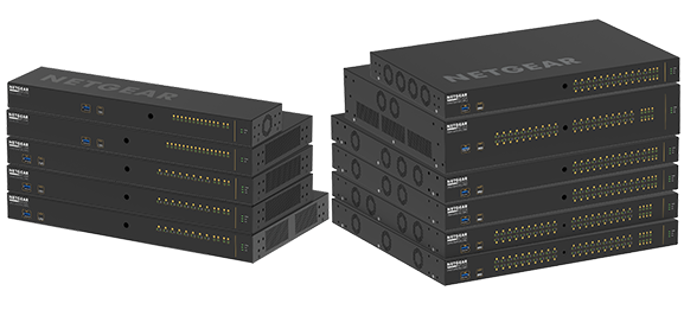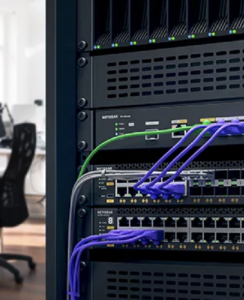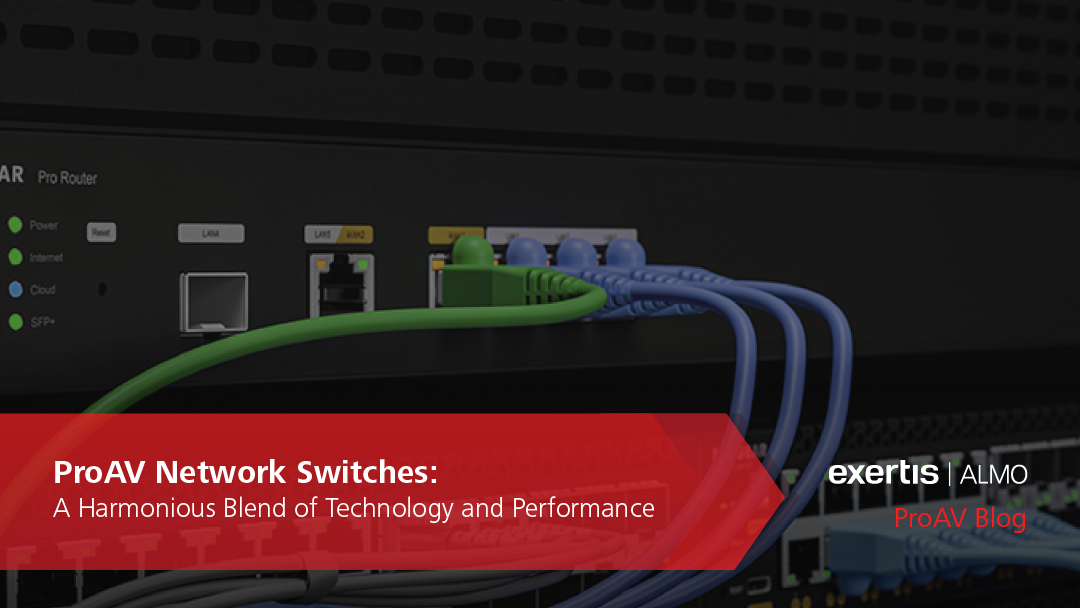The World of ProAV Network Switches
In the realm of professional audio-visual (Pro AV) technology, where every decibel matters and every pixel counts, the unseen heroes orchestrating seamless operations are network switches. Often overlooked but absolutely crucial, these silent conductors form the backbone of modern AV systems, ensuring that audio and video signals flow flawlessly, without hiccups or delays. Let’s dive into the world of network switches in professional AV and uncover the magic they bring to the stage.
 Imagine a large-scale conference, a live concert, or a corporate presentation. Behind the scenes, there’s a complex network of AV equipment working tirelessly to deliver an immersive experience to the audience. At the heart of this network lies the network switch, serving as a central hub that connects various AV devices such as cameras, microphones, speakers, displays, and media servers.
Imagine a large-scale conference, a live concert, or a corporate presentation. Behind the scenes, there’s a complex network of AV equipment working tirelessly to deliver an immersive experience to the audience. At the heart of this network lies the network switch, serving as a central hub that connects various AV devices such as cameras, microphones, speakers, displays, and media servers.
Performance and Reliability
In Pro AV environments, reliability is non-negotiable. Network switches designed for this industry prioritize uptime and stability, utilizing advanced features like Quality of Service (QoS), redundancy protocols, and multicast support to ensure that audio and video streams are transmitted without interruption. Whether it’s a high-definition video feed or multi-channel audio, these switches deliver uncompromising performance, allowing professionals to focus on their craft without worrying about technical glitches.
Bandwidth and Throughput
One of the key challenges in AV networking is managing bandwidth and throughput effectively. With the rise of ultra-high-definition (UHD) content and immersive audio formats, the demand for data-intensive applications has surged. Network switches tailored for professional AV environments are equipped with high-speed ports, advanced traffic management capabilities, and ample throughput to handle the demands of modern multimedia.
Many AV installations require real-time streaming and low-latency communication, making ultra-fast switching crucial. With features like low latency forwarding and buffering, specialized network switches minimize delay and jitter, ensuring that audio and video signals reach their destination with minimal latency, preserving synchronization and enhancing the overall user experience.
Management and Control
In the world of professional AV, flexibility and control are paramount. Network switches offer sophisticated management options, allowing administrators to configure, monitor, and troubleshoot the network with ease. From intuitive web-based interfaces to powerful command-line tools, these switches provide a range of management capabilities tailored to the needs of AV professionals.
Furthermore, network switches play a crucial role in network security, safeguarding sensitive audiovisual content from unauthorized access or tampering. With support for advanced security features such as Access Control Lists (ACLs), port security, and encryption, these switches ensure that data remains confidential, and integrity is maintained throughout the AV ecosystem.
Scalability and Adaptability
As AV installations grow in complexity and scale, network infrastructure must evolve to accommodate changing requirements. Network switches offer scalability and adaptability, allowing organizations to expand their AV systems seamlessly without sacrificing performance or reliability. Whether it’s adding new endpoints, integrating emerging technologies, or supporting larger audiences, these switches provide the flexibility to scale up or down as needed.
Moreover, network switches in professional AV are designed to integrate with other components of the ecosystem, such as audio processors, video matrix switchers, and control systems. Through standards-based protocols like Dante, AVB, and AES67, these switches enable interoperability and seamless communication between different devices, creating a unified and cohesive AV environment.
Power over Ethernet and Future Innovations
Let’s also not forget about Power over Ethernet (PoE) for supplying power to the devices in our AV system. Many AV devices, such as IP cameras, wireless access points, and digital signage displays, rely on Power over Ethernet (PoE) from switches for power and data transmission. Ensure that the network switch provides adequate PoE support, including the required power budget and compatibility with PoE standards such as IEEE 802.3af, IEEE 802.3at (PoE+), or IEEE 802.3bt (PoE++), depending on the power needs of the connected devices. (See PoE reference guide below)
 As technology continues to evolve, network switches will continue to play a pivotal role in shaping the future of professional AV, enabling new possibilities and pushing the boundaries of what is possible in terms of performance, reliability, and scalability. One network switch manufacturer leading the charge in the Pro AV industry is Netgear. They provide purpose-built layer 3 switches with preconfigured network protocols like IGMP snooping, multicast routing, and fast leave mechanisms, to optimize multicast traffic delivery and conserve network bandwidth. Netgear also continues to develop switches that include certified profile setup configurations including NDI, SRT, Dante, AES, AVB and many others for audio/video/lighting/control. Adding a simplified custom AV user interface that doesn’t require an IT administrator to configure, and generous PoE power for all AV components in the system is a grand slam for Pro AV integrators.
As technology continues to evolve, network switches will continue to play a pivotal role in shaping the future of professional AV, enabling new possibilities and pushing the boundaries of what is possible in terms of performance, reliability, and scalability. One network switch manufacturer leading the charge in the Pro AV industry is Netgear. They provide purpose-built layer 3 switches with preconfigured network protocols like IGMP snooping, multicast routing, and fast leave mechanisms, to optimize multicast traffic delivery and conserve network bandwidth. Netgear also continues to develop switches that include certified profile setup configurations including NDI, SRT, Dante, AES, AVB and many others for audio/video/lighting/control. Adding a simplified custom AV user interface that doesn’t require an IT administrator to configure, and generous PoE power for all AV components in the system is a grand slam for Pro AV integrators.
Power over Ethernet (PoE) is categorized into different classes based on the power levels they can deliver. These classes are defined by the IEEE 802.3 standard. Here’s a breakdown of the main PoE classes and their differences:
1. IEEE 802.3af (PoE, Class 1-3):
-
- Power Output: Provides up to 15.4 watts of DC power per port.
- Application: Suitable for low-power devices such as IP phones, wireless access points, many encoders and decoders, and IP cameras.
- Classification: Devices are classified into three power classes (Class 1-3) based on their power requirements. Class 1 devices require the least power, while Class 3 devices can consume up to 15.4 watts.
2. IEEE 802.3at (PoE+):
-
- Power Output: Provides up to 30 watts of DC power per port.
- Application: Designed for higher-power devices such as PTZ cameras, video conferencing systems, and access control systems.
- Classification: PoE+ introduces a higher power class (Class 4) to support devices with greater power demands. Class 4 devices can consume up to 30 watts.
3. IEEE 802.3bt (PoE++):
-
- Power Output: Provides up to 90 watts of DC power per port.
- Application: Intended for high-power devices such as pan-tilt-zoom (PTZ) cameras, high-performance wireless access points, and IoT devices with integrated sensors and actuators.
- Classification: PoE++ introduces four power classes (Class 5-8) to support a wide range of devices with varying power requirements. Class 5 devices can consume up to 45 watts, Class 6 up to 60 watts, Class 7 up to 75 watts, and Class 8 up to 90 watts.
*The primary difference between these PoE classes lies in the amount of power they can deliver to connected devices. As the class number increases, so does the maximum power output per port.
**It’s essential for users to choose the appropriate PoE class based on the power requirements of their devices to ensure optimal performance and compatibility.
***Don’t forget to calculate the system’s Total Power Budget when factoring in PoE requirements.










